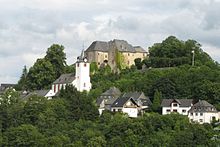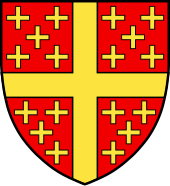Reign of Westerburg
The rule of Westerburg , a small area around today's town of Westerburg in the Westerwald , was first documented in 1209. The local castle of the same name , which was built much earlier and was first mentioned in 1192, became the ancestral seat of the Lords of Westerburg, a branch of the Lords of Runkel .
Forerunner: The Lords of Runkel
The Lords of Westerburg go back to the Runkel house, which had its headquarters at Runkel Castle on the Lahn. After this older branch died out, however, the Westerburg lords largely took over the ownership rights of their Runkeler relatives.
The Runkel house is mentioned for the first time in a document dated April 1, 1159. At that time, a Siegfried I. von Runkel was a witness when the lords of Laurenburg, later called House Nassau , received Nassau Castle as a fief. It is possible that the dominance of the House of Runkel was already in the Westerburg area. This is indicated by the fact that Runkel Castle only had a very small manor in the immediate vicinity.
Foundation and initial history
Siegfried III. By marrying a countess from the Leininger family, von Runkel acquired both Westerburg and the bailiwick through the St. Severus monastery in Gemünden, and since then has called himself Siegfried von Runkel and von Westerburg. Two of his sons inherited him: Siegfried IV von Runkel, who resided in Westerburg, and Dietrich I. von Runkel, who was based in Runkel. Family disputes began as early as 1250, which led to the final separation of the Runkel and Westerburg rulers among Siegfried's grandchildren in 1288 at the latest. Dietrich's son Siegfried V von Runkel ousted his cousin Heinrich from Runkel, and he, a son of Siegfried IV, was now called Heinrich II von Westerburg. He reinforced the hostility by building the Schadeck Castle, first mentioned in 1288, on the north bank of the Lahn opposite Runkel . Through his marriage to Agnes, daughter of Gerlach von Limburg , Heinrich also won the reign of Schaumburg and a sixth of the reign of Cleeberg .
Heinrich von Westerburg († 1288) was followed by seven generations of direct descendants as Lords of Westerburg:
- Siegfried von Westerburg († 1315)
- Reinhard I of Westerburg († 1353)
- Johann I of Westerburg (* 1332, † 1370)
- Reinhard II of Westerburg (* 1354, † 1421)
- Reinhard III. von Westerburg († 1449)
- Kuno I of Westerburg (* 1425, † 1459)
- Reinhard IV. (* 1453, † 1522), from 1475 Reinhard I of Leiningen-Westerburg
The rulership, like the other smaller rulers between the Rhine, Main and Sieg, was almost constantly under pressure from the Archbishopric of Trier and the expansive Counts of Nassau , and the Westerburg family therefore sought to secure itself through marital connections with the other houses in the area. so u. a. with Isenburg , Limburg , Solms , Merenberg , Sayn , Virneburg , Leiningen, Wied , Cronberg , Diez , Weilnau , Runkel and also Nassau-Wiesbaden.
Merger with Leiningen
When, with the death of Count Hesso von Leiningen-Dagsburg on March 8, 1467, this branch of the Leiningen counts died out in the male line, his sister Margarete, married to Reinhard III, inherited. von Westerburg, the greater part of the possession of this older main line of the Leininger, and the Westerburg called themselves Leiningen-Westerburg since then . When Countess Margarethe died in 1470, her entire Westerburg and Leiningen inheritance fell to her grandson Reinhard IV, who from 1475 onwards, with the imperial approval, called himself Count Reinhard I zu Leiningen-Westerburg and moved his seat to the Leiningen county. His son Kuno III. († 1547) had three sons who founded the three lines of the sex.
Headquarters of Leininger branch lines
It was not until 1557 that Westerburg was again the seat of branch lines of the house of the Leininger, which was repeatedly split up. The three branches of Leiningen-Leiningen, Leiningen-Westerburg and Leiningen-Schaumburg were created under Reinhard's grandchildren. Reinhard II zu Leiningen-Westerburg (* 1530, † 1584) resided in Westerburg from 1557, but the Leiningen-Westerburg line expired in 1597 with his sons Albrecht Philipp (* 1567, † 1597) and Johann Ludwig (* 1572, † 1597) ). It was inherited by the Leiningen-Schaumburg line, which also branched out further from 1695 and from which two branch lines existed until the 20th century: Leiningen-Westerburg-Altleiningen and Leiningen-Westerburg-Neuleiningen.
In 1656 the people of Leiningen had to formally hand over the feudal sovereignty over the Westerburg rule to the Electorate of Cologne as part of a surrogation for the sold Electoral Cologne fiefdom Schaumburg .
The End
In 1806 Westerburg was added to the Grand Duchy of Berg in the course of the formation of the Rhine Confederation under Napoleon , but came to the Duchy of Nassau in 1813/1815 and in 1866 with the annexation of Nassau to Prussia . Since 1946 the area of the former rule Westerburg belongs to Rhineland-Palatinate .
coat of arms
The family coat of arms of the Westerburger shows a continuous golden cross in red, angled by 20 (4 × 5 (2: 1: 2)) golden crosses. On the helmet with red-gold covers a red or black flight, covered with a red disc with a continuous gold cross, angled by 5 (2: 1: 2) gold crosses (also reduced to one each at an angle), or else a flight marked like the shield.
Members of the house
- Siegfried von Westerburg , 1275–1297 Archbishop of Cologne
- Seraphine Franziska zu Leiningen-Westerburg-Neuleiningen (1810–1874), Countess, member of the First Chamber of the Estates of the Duchy of Nassau, lived as a registrar on the Westerburg.
literature
- Sante, Wilhelm: History of the German Lands - Territories Ploetz . Wuerzburg 1964.
- Köbler, Gerhard: Historical lexicon of the German countries. Munich 1988.
Web links
- History of the county of Westerburg-Leiningen, with map
- Genealogy of the house of Runkel
- Genealogy of the house of Leiningen-Westerburg
- Genealogy of the house of Leiningen-Westerburg-Schaumburg as well as Altleiningen and Neuleiningen
- Runkel Castle website
Individual evidence
- ^ Bernhard Peter, historical heraldic ex-libris (1) ; The heraldic bookmarks of the Counts of Leiningen-Westerburg


